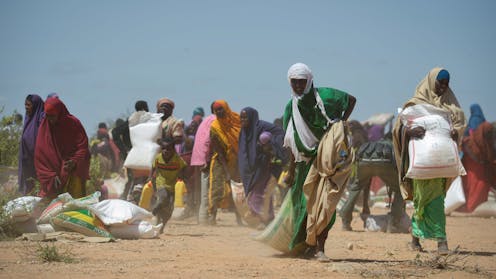Source: The Conversation – Africa (2) – By Hamza Benattia, Prehistory, Universitat de Barcelona
A new archaeological discovery at Kach Kouch in Morocco challenges the long-held belief that the Maghreb (north-west Africa) was an empty land before the arrival of the Phoenicians from the Middle East in around 800 BCE. It reveals a much richer and more complex history than previously thought.
Everything found at the site indicates that during the Bronze Age, more than 3,000 years ago, stable agricultural settlements already existed on the African coast of the Mediterranean.
This was at the same time as societies such as the Mycenaean flourished in the eastern Mediterranean.
Our discovery, led by a team of young researchers from Morocco’s National Institute of Archaeology, expands our knowledge of the recent prehistory of north Africa. It also redefines our understanding of the connections between the Maghreb and the rest of the Mediterranean in ancient times.
How the discovery was made
Kach Kouch was first identified in 1988 and first excavated in 1992. At the time, researchers believed the site had been inhabited between the 8th and 6th centuries BCE. This was based on the Phoenician pottery that was found.
Nearly 30 years later, our team carried out two new excavation seasons in 2021 and 2022. Our investigations included cutting-edge technology such as drones, differential GPS (global positioning systems) and 3D models.
A rigorous protocol was followed for collecting samples. This allowed us to detect fossilised remains of seeds and charcoal.
Subsequently, a series of analyses allowed us to reconstruct the settlement’s economy and its natural environment in prehistoric times.
What the remains revealed
The excavations, along with radiocarbon dating, revealed that the settlement underwent three phases of occupation between 2200 and 600 BCE.
The earliest documented remains (2200–2000 BCE) are scarce. They consist of three undecorated pottery sherds, a flint flake and a cow bone.
The scarcity of materials and contexts could be due to erosion or a temporary occupation of the hill during this phase.
In its second phase, after a period of abandonment, the Kach Kouch hill was permanently occupied from 1300 BCE. Its inhabitants, who probably numbered no more than a hundred, dedicated themselves to agriculture and animal husbandry.
They lived in circular dwellings built from wattle and daub, a technique that combines wooden poles, reeds and mud. They dug silos into the rock to store agricultural products.
Analysis shows that they cultivated wheat, barley and legumes, and raised cattle, sheep, goats and pigs.
They also used grinding stones for cereal processing, flint tools, and decorated pottery. In addition, the oldest known bronze object in north Africa (excluding Egypt) has been documented. It is probably a scrap metal fragment removed after casting in a mould.
Interactions with the Phoenicians
Between the 8th and 7th centuries BCE, during the so-called Mauretanian period, the inhabitants of Kach Kouch maintained the same material culture, architecture and economy as in the previous phase. However, interactions with Phoenician communities that were starting to settle in nearby sites, such as Lixus, brought new cultural practices.
For example, circular dwellings coexisted with square ones made of stone and wattle and daub, combining Phoenician and local construction techniques.
Furthermore, new crops began to be cultivated, like grapes and olives. Among the new materials, wheel-made Phoenician ceramics, such as amphorae (storage jugs) and plates, and the use of iron objects stand out.
Around 600 BCE, Kach Kouch was peacefully abandoned, perhaps due to social and economic changes. Its inhabitants likely moved to other nearby settlements.
So who were the Bronze Age inhabitants?
It’s unclear whether the Maghreb populations in the Bronze Age lived in tribes, as would later occur during the Mauretanian period. They were probably organised as families. Burials suggest there were no clear signs of hierarchy.
They may have spoken a language similar to the Amazigh, the indigenous north African language, which did not become written until the introduction of the Phoenician alphabet. The cultural continuity documented at Kach Kouch suggests that these populations are the direct ancestors of the Mauretanian peoples of north-west Africa.
Why this matters
Kach Kouch is not only the first and oldest known Bronze Age settlement in the Maghreb but also reshapes our understanding of prehistory in this region.
The new findings, along with other recent discoveries, demonstrate that north-west Africa has been connected to other regions of the Mediterranean, the Atlantic and the Sahara since prehistoric times.
Our findings challenge traditional narratives, many of which were influenced by colonial views that portrayed the Maghreb as an empty and isolated land until it was “civilized” by foreign peoples.
As a result, the Maghreb has long been absent from debates on the later prehistory of the Mediterranean. These new discoveries not only represent a breakthrough for archaeology, but also a call to reconsider dominant historical narratives. Kach Kouch offers the opportunity to rewrite north Africa’s history and give it the visibility it has always deserved.
We believe this is a decisive moment for research that could forever change the way we understand not only the history of north Africa, but also its relationship with other areas of the Mediterranean.
![]()
Hamza Benattia, director of the Kach Kouch Archaeological Project, received funding from the National Institute of Archaeology and Heritage of Morocco (INSAP), the Prehistoric Society Research Fund, the Stevan B. Dana Grant of the American Society of Overseas Research, the Mediterranean Archaeological Trust Grant, the Barakat Trust Early Career Award, the Centre Jacques Berque Research Grant, the Institute of Ceutan Studies Research Fund and the University of Castilla La Mancha.
– ref. Discovery of a 4,000-year-old Bronze Age settlement in Morocco rewrites history – https://theconversation.com/discovery-of-a-4-000-year-old-bronze-age-settlement-in-morocco-rewrites-history-253172

